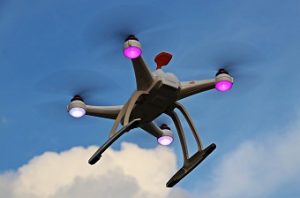
There continues to be a lot of debate surrounding the security applications of drone technology. The IHS Markit video surveillance group included them in its Video Surveillance Trends for 2017 and we followed suit last June, citing drones as one of five new innovations a video management system (VMS) can deliver. The same month, the popular Drone Zone made a return to IFSEC International in London. So why have drones failed to take off as projected?
PwC has forecasted that by 2020, the security drone market will be worth $10.bn. That’s a lot of drones and I anticipate we will in time see more drones used in safety and security applications such as:
• Gaining a birds-eye view – firefighting and commercial use
• Tracking suspects or vehicles across distances
• Crowd control – at events, protests, etc
• Guard duty – patrolling and perimeter protection
• Anti-drone technology – detecting nefarious drones
However, before we see mass adoption become a reality, a few issues need to be resolved.
Typically, a commercial drone has a battery life/flight-time of approximately 25 minutes. This is no problem for certain use cases, such as firefighters using a drone to get a birds-eye view of the situation their crew is facing (and this is already happening).
However, for applications such as guarding and perimeter protection, where 24/7 capacity is required, such a limited battery life limits their usefulness.
As with much technology, costs are on a downward trend and high-performance drones are becoming more affordable. But the problem isn’t unit cost, but the number of drones needed in order to effectively carry out certain tasks. For example, a drone could potentially be very effective in perimeter protection, and the limited battery-life issue could be circumvented by a rotating fleet of drones. But this would be expensive, especially if manned guards are still required.
As with so much technology that finds its way into the security industry, drones have a military background and are the ‘offspring’ of UAVs (unmanned aerial aircraft), which were created for use on (or to be precise, above) the battlefield. With drones considered an aircraft, there are important regulatory issues to consider before using them for security or commercial purposes. These are not limited to aviation. Because of their surveillance capabilities, governance concerning consumer data protection and privacy need also be factored in.
Governments and industry are keen to push forward in applying relevant regulations in order not to stifle this important technology. Until the regulatory framework is clearer, the market is adopting a wait-and-see stance with regards to full-scale adoption.
Drones unquestionably have huge potential for use in the security industry and predictions are that the market will burgeon. As mentioned, they are already being used by firefighters to gain an invaluable new perspective on fires and better situational awareness. They are also being used detect movement and, armed with video monitoring capabilities, can transmit real-time footage of what is happening at the scene of an incident.
Drones are here to stay and the security industry is rapidly trying to figure out how to expand use and accelerate adoption. With the likes of Amazon’s well-publicised investment in drone technology, the security market will certainly benefit from research and development undertaken in other industries. In the meantime, security vendors and users of security technology are working together to leverage drones within existing parameters.











